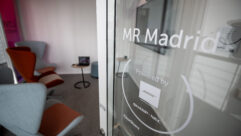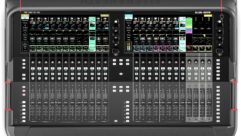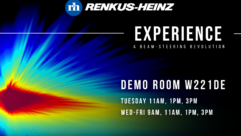
Retail Center Adds Flexible Audio
Distributed audio system adds ambience and diverse capabilities to a retail/entertainment center in Hollywood, FL.
The new retail/entertainment district at Seminole paradise Hard Rock Hotel and Casino features a distributed audio system that runs more than 1,500 feet via Cat6 and fiber cable to two Digigram Ethersound units inside the retail center. The audio system feeds 36 JBL Control 29AV-WH loudspeakers, which are mounted inside the corridors of the center and on the outside of the buildings.
CHALLENGE: Design an easy to use, multi-zone audio system that features independent volume controls and can run over an extremely long distance.
SOLUTION: Use the existing fiber backbone and add Cat6 cable to distribute audio signals, and include proprietary volume controls to manage each audio zone.
Less than a month before the March 2005 opening of the retail/entertainment district at Seminole Paradise at the Seminole Hard Rock Hotel and Casino in Hollywood, FL, it was determined that the original audio design for the project needed to be updated. The sprawling, 86-acre full-service resort, which includes a hotel and casino, a 5,600-seat arena, 22 shops, 17 restaurants including a Hard Rock Café, a 4-acre, lagoon-style pool and beach club, and a lighted, programmable fountain and water theater, had originally planned to add a multi-zone distributed audio system, but updated the design to incorporate a Digigram EtherSound digital audio network system.
Steve Duvall, field project manager with Baltimore, MD-based Cordish Company, Seminole Paradise’s development firm, subcontracted Adam Leopold, current owner and systems designer at Caribbean Systems Integration, to update and install a new system that could seamlessly deliver background music, accommodate live events, and eventually broadcast live performances from the nearby arena.
“The system needed to be straightforward, bulletproof, and easy to link with other audio systems at the site in the future,” Leopold says. “We also needed a system with next to zero lag time over long distances, and volume control by zone.”
Sending the signal
After researching possible solutions for distributing the sound over long distances, Leopold selected Digigram’s EtherSound digital audio network. He says he chose the EtherSound product because it’s simple to install and operate, and also solved one of the major technical challenges of the project: sending audio signals over multiple paths.
As part of the original plan, the intermediate distribution facility (IDF) maintenance closets that house the electrical systems for the center are linked by a fiber backbone. For the new EtherSound system, Duvall used Cat6 cable for shorter 300-foot runs from the first EtherSound unit to the fiber backbone, and 165 feet from the fiber backbone to the second EtherSound unit.
“We went with Cat6, as opposed to Cat5e, to take advantage of the greater bandwidth — 250 MHz compared to 100 MHz — for future high-speed applications,” Duvall says.
Converting Between Fiber And Copper
The challenges of converting between fiber and copper cable, such as in the distributed audio system at the new retail/entertainment center at the Seminole Paradise at Seminole Hard Rock Hotel and Casino in Hollywood, FL, can be relatively painless if both cables’ speed and distance capabilities are properly matched for each other and for the application.
Daryl Hunt, product manager at Groveport, OH-based computer products manufacturer StarTech.com, which manufactured the ET9003SC media converter used in the Seminole Paradise project, says that because this project included a plan for future expansion, using Cat6 copper cable was the logical choice. “If there’s a perceived need to move to applications that demand gigabit speeds in the future (videoconferencing and VoIP), Cat6 is the best choice for a high degree of reliability and maximum data transfer rates,” he says. “It offers more flexibility for future upgrades without the need to change the underlying cable infrastructure.”
Along with choosing between copper cable options, the choice of the type of fiber is equally important, Hunt says. “In general, multimode fiber cable is used for shorter runs up to 1.2 miles at 100 Mb/s, while single-mode cable is used for long runs up to 12 miles at 100 Mb/s.”
Hunt also says that the way the cables and connectors work together in a multi-format system is also important. “Multimode and single-mode equipment and cable are generally not interchangeable,” he says. “You should ensure that all your fiber cable and equipment uses the same ends (ST, SC, etc.) to avoid using additional converters or non-standard cables.”
If the types of cable have been carefully selected, converting the signal isn’t complicated, Hunt adds. “The ET9003SC media converter translates the pulses of light that travel in specific configuration over fiber optic cable into standard Ethernet electrical signals transmittable over copper wires,” he says. “The process is transparent to devices and users on the network.”
Once the distribution system was selected, Leopold began piecing together the rest of the system. The primary audio source for the retail center is a programmed music service from Muzak, which is streamed in through the Internet via a computer located at the head-end unit in the retail center’s IT closet. The head end also includes a Shure 552 push-to-talk microphone and a Sony CPD-CE375 CD player as secondary source options for the system. All three sources are routed at the head end into a Rane RPM88 digital signal processor, which sends the music signal to two EtherSound ES8out units in the shopping center. The sources can be selected and switched at the head end at any time.
The head end also includes a Cisco Catalyst 2950 network router, which acts an as interface between the audio system and the existing network. “It provides abundant open ports for programming/testing links from the head end to the first IDF closet,” Leopold says.
From the head end, the audio signals are outputted from the Rane processor to two identical EtherSound-equipped Middle Atlantic Rack EWR Wall Mount Series racks — each of which route the audio to the six zones throughout the retail center. Reaching the first EtherSound station didn’t present much of a challenge because it’s located in the same room as the head end, but getting the signal to the second rack meant sending it over the fiber backbone and Cat6 cable more than 1,500 feet to the other end of the retail center. In order to get to IDF Closet 14, where the second EtherSound ES8out unit is located, Leopold routed the audio signal through the IDF Closets 5, 7, and 12 using the fiber backbone (see Fig. 1 on page 34).
Out of IDF Closet 1, the signal is run via Cat6 cable to IDF Closet 5, where the fiber backbone begins. A multimode, two-strand StarTech ET9003SC media converter then converts the signal from Cat6 to fiber. Leopold says the signal had to be converted to the fiber backbone because of signal distance limitations of Cat6. Once on the fiber backbone, the signal passes to IDF Closets 7 and 12. At IDF Closet 12, the signal is tapped out of the fiber network and converted back to Cat6 with another StarTech ET9003SC media converter. The signal is then sent to IDF Closet 14, where the second rack is located.
Controlling the volume
Once the system was designed and the distribution method was mapped out, Leopold had to address another challenge. When the system was installed in early 2005, the EtherSound system was so new that it didn’t have volume controls for individual zones. While music in the retail center is most often played at a consistent volume in all zones, different events sometimes require the volume to be regulated by zone.
The solution was to use Crown Audio’s CTs 8200 eight-channel, 70 V amplifier, which has enough power to serve all six zones, and would also solve the volume control problems. When Leopold was looking for an amplifier, Crown had recently introduced its 4 VCAP four-pot volume control cards, which can be integrated into the company’s multichannel amplifiers.
“This solved two issues,” Leopold says. “I had a multichannel amp that would cover several zones, and it had volume controls that matched the amps and didn’t need to be wired in line with the speakers somewhere. They already communicated with the amplifiers because they belonged to the amplifiers.”
Fig. 1. Audio signals are routed via Cat6 cable and fiber backbone through IDF closets between EtherSound units.
In addition to the EtherSound system, using the Crown amplifiers and volume control also enabled Leopold to cut thousands of dollars off the audio system’s original budget. “In the original system, there was RS485 control at one point, but only for one piece; the rest was RS232, and the CobraNet-enabled product at the end cost $5,000 itself,” Leopold says. “We were able to do everything the original design called for with three pieces, when the original design called for 25 pieces and more than $25,000. The EtherSound system and Crown equipment saved the client almost $10,000.”
The Crown amplifiers solved the system’s volume control problems, and an Extron Crosspoint 50 12×8 audio-only matrix switcher enabled Leopold to split the signal into six channels from the EtherSound ES8out module to get the signal to the amplifiers. Each of the six outputs from the Extron matrix is fed into an input on the Crown amplifiers, which then route the signals to the loudspeakers throughout the retail center.
“The matrix provided gain control to match the different levels for different zones,” Leopold says. “Most Extron switchers provide a small degree of audio input attenuation through front-panel buttons. This allowed us to further match the levels of the inputs.”
Indoor/outdoor sound
Leopold’s next challenge was to make the sound come alive. The shopping center features large, expansive areas that require powerful speakers, and small, intimate areas where more subtle sound is needed.
For the larger spaces inside and outside the center, Leopold installed 36 JBL Control Contractor 29AV-WH 70 V loudspeakers. In any given area, they’re either staggered through the mall two stories up, designed to overlap at the angle they’re specified for, or designed to shoot down an alley. In the central courtyard, there are four JBL 29AV-WH loudspeakers that form a circle around a fountain. The entrance area features two JBL 29AV-WH loudspeakers hidden behind grating on an architectural sign banner.
For More Information
- Atlas Soundwww.atlassound.com
- Cisco Systemswww.cisco.com
- Crownwww.crownaudio.com
- Digigramwww.digigram.com
- Extronwww.extron.com
- JBLwww.jblpro.com
- Middle Atlanticwww.middleatlantic.com
- Muzakwww.muzak.com
- Ranewww.rane.com
- Shurewww.shure.com
- Sonywww.sony.com
- StarTechwww.startech.com
For the smaller outdoor spaces, Leopold installed 24 Atlas Sound ATS183G 70 V garden loudspeakers. “They’re not very loud, but we placed those closer together in planter boxes,” Leopold says. “They blend in with the plants around them. The Atlas speakers give just enough in the narrow areas to fill in the ambience of the music. You don’t hear a dead spot as you walk through.”
However, installing the speakers posed a major logistical challenge because the conduit had been placed long before Leopold started installing the audio system. “To accommodate the tenants and because the conduit was designed for the original audio system, we actually had to route some of our loudspeaker wire nowhere near where they were going to end up.” Leopold says.
Planning for expansion
Now that the system is in place and working without any problems, Leopold is currently planning an expansion to connect audio from all of the sources at the complex to the head end in the retail center. From there, he can add EtherSound units and send the audio signals to new buildings or properties at Seminole Paradise.
Paul Kramer is associate editor of Pro AV. He can be reached at [email protected].










